Charge of the Light Brigade: Battle of Balaclava – Nashcon (5-23-2014)
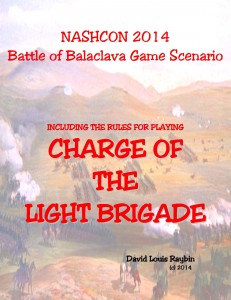
David and Ben Raybin ran two fantastic Crimean War games at Nashcon this past Memorial Day weekend. The first game was on Friday afternoon and was a smaller game featuring the Charge of the Light Brigade! Here is the game description:
Twixt Cannon and Cossack: The Battle of Balaclava / Crimea 1854 – The Charge of the Light Brigade! This year is the 160th anniversary of the Battle of Balaclava. David and Ben Raybin present the first public appearance of this grand scenario, one of their most popular games, in a decade. There will be a field six feet wide by twenty-four feet in length to represent the main battlefield and Balaclava harbor with several ships at anchor. Each side starts out in historically accurate positions….including Lord Cardigan who was asleep on his yacht in Balaclava harbor. When the battle opens, it finds a host of Russians attacking the only British supply port. Will the Turks hold? Where are the French? Yours in not to reason why, Yours is but to do or die. “The Charge of the Light Brigade” rules and the game scenario are available on-line in the HMGS-Mid-South downloads section. This 28mm scale game has room for 12 players. Come ride with the 600 into the valley of death, straight into the mouth of Hell! Here is the link to the rules: http://hmgs-midsouth.org/downloads/
David and Ben’s second game on Friday night, The Battle of Balaclava, used the same terrain, but was a much bigger affair with lots and lots of infantry, cavalry and artillery units. David and Ben’s game looked great and used their simple, fast play rules to keep the action moving along. I spoke with several of the gamers that played in the game and they had a grand time! The Battle of Balaclava won the Cigarboxbattle.com “Superior Game Presentation” award for the Saturday night time slot. Congratulations guy! It was really a magnificent game!
Here is a write-up that David and Ben provided for us and some pictures of their game. Click on all images to see them at full size
Introduction by David and Ben Raybin:
This year is the 160th anniversary of the Battle of Balaclava. The Nashcon war game convention was our opportunity to refight the battle using our Charge of the Light Brigade Rules. Cigarboxbattle.com asked us to do a write-up of the game and the rules.
Each side started out in historically accurate positions – including Lord Cardigan, who is asleep on his yacht in Balaclava harbor. The organization of the various units is as outlined in the Rules in that battalions are represented by six 4-man stands, cavalry by six 2-man stands and a battery with three model guns and six figures.
Our field was six feet wide by twenty-four feet in length representing the main battlefield and Balaclava harbor and several ships at anchor. Over a thousand 25 millimeter troops were available for the game.
The Russians had the burden of attack and had to do so promptly lest Allied reinforcements from the trenches prove decisive. The allies could not denude the trenches around Sevastopol however without risking a sortie from the besieged Russians.
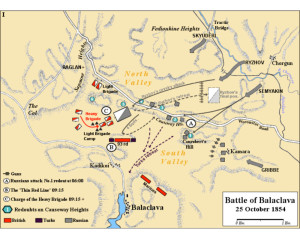
The actual battle – fought in 1854 – involved the Russians attacking the Turks in the several redoubts and driving the Turks back. The Russian cavalry then advanced toward Balaclava. The “Thin Red line” — the 93rd Highlanders — stopped the attacking Russian horse. The British Heavy Brigade repulsed an even larger force of Russian cavalry.
In the real battle the British could see that some of the allied guns in the redoubts were being dragged away by the Russians. Wellington had never lost a gun and the British general (who had lost an arm at Waterloo) was not about to lose any guns either. Thus, he commanded his cavalry to “capture the guns.” Unfortunately, the cavalry commander in the valley below could not see the guns his general could see from the heights above. But what the cavalry could see were Russian guns a mile or so away. The British — “not to reason why, but to do or die” — charged: the now infamous Charge of the Light Brigade. Allied infantry finally arrived from the trenches to effectively end the battle.
The result of the actual battle was what we would call a minor tactical victory for the Russians since they remained in control of the redoubts which threatened but did not cut the supply line. However, the port of Balaclava was saved, the loss of which would have been disastrous for the British.
The object of our game is for the Russians to take the port of Balaclava, or more realistically, to block the road from the port to the trenches. If they can accomplish this with sufficient force they have won a major victory for they have effectively lifted the siege of Sevastopol and won the war. The allies — to win a major victory — must retake the redoubts the Turks will abandon early in the game.
The Game Itself:
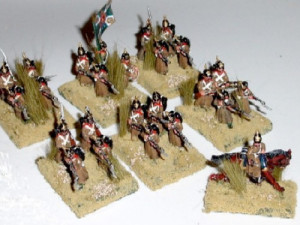
Troops are organized in a uniform manner. Infantry are 4 castings to a stand (2 up and 2 back) with 6 stands to a “unit” plus one additional leader figure who is usually mounted. Cavalry have 2 figures to a stand with 6 stands and a command figure per unit. Each battery has three stands with a piece and 2 figures per stand and no separate command stand.
Troops are on square bases. Higher command figures are round stands with, in my army, a mounted figure plus one on foot. The army commanders are usually five or six figures on a “diorama-type base.”
An infantry and cavalry “unit” represent about 500 to 1000 actual men but I do not worry overly much about such things. I just call them “regiments” and let it go at that. Remember that the name of the game is simplicity. We use six-sided dice because they are easier to read. Depending on the number of players, each person playing the game should command about two to three units.
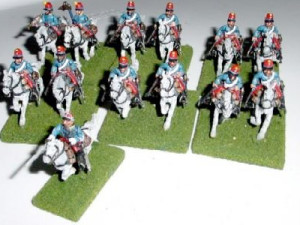
The rules for the game are a variation of my Charge of the Light Brigade specifically designed for the Crimean War. Everyone was provided with a play sheet which had the charts and an outline of the rules.
When the turn begins each side rolls for initiative. The side which had the initiative last turn adds one to the die roll since, in this game, if you have the initiative you tend to keep it. If you won more close combats than the other side there is an additional modifier. The side winning the initiative gets his choice of who acts first that turn.
During a player’s turn all units on a side can do any one action of their choice. An action is: a move, fire, close combat, limber, unlimber, dismount etc. The point is that a unit is limited to only one action of its choice per turn.
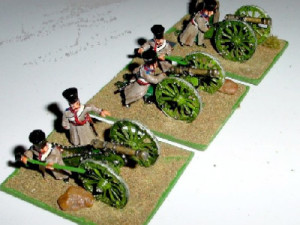
A unit may use a “command point” to add extra dice to an activity such as an extra dice for movement. A limited number of command points keeps folks on edge because you cannot afford to use command points for every unit for every turn. The command points are written on a slip of sticky paper underneath the leader or one of the guns. When a command point is expended a hash mark is made on the slip. The ability to use command points, in effect, represents a unit’s extra energy to “double time” or execute a charge. The better units have more command points and thus can do more things during a game. This also eliminates a host of other variables which tend to complicate things – and thus otherwise slow down the game.
Movement in the game is by die roll; each pip representing an inch. A unit in line can move 2 dice….in column 3 dice. There are die penalties for terrain and that sort of thing. Given the relatively low number of units in the game allows for movement by die roll which a lot of folks seem to enjoy.
Changing formation in this game is an action as is unlimbering or limbering guns. My idea is that each action represents a brief moment in “real time.” Artillery cannot shoot and scoot in the same turn like a modern tank. These were the days of limbered guns and it took some time to gather up the pieces before moving away to a new position.
Fire is simple. Each stand throws a die and a table shows if there is a possible “hit.” This considers weapon type and target. You have seen a dozen charts like this. Long range is half hits rounded up. Rifles fire out to 20″ and artillery at 40″. Remember, you only get one shot per turn.
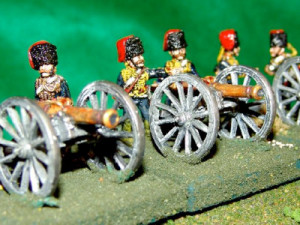
Even after a possible hit is scored, the unit gets to roll on the “save chart” to see if it can avoid the casualty. The chart is nonlinear, which is to say there is a greater probability for a save — at least for some units — when the unit is at full strength then when the unit is reduced to, say, 30% of the stands. This process is to represent the higher quality of one unit over another in that one can take the same amount of punishment and still retain a higher combat effectiveness. In short, the better units fight at “normal” strength for a long time and then – when they reach a certain damage level – they evaporate. Poor quality units diminish proportionally as they take losses. You don’t have to worry about any of this as you play since the save chart does all the work for you.
The morale rules are also simple. There are a number of things which cause a morale chit. It is the normal stuff like-losing a leader or having a unit rout near you . . . that sort- of thing. Another morale event is if an enemy unit throws two sixes in a single fire phase. If a “bad” morale event happens to the unit the target unit draws a morale chit representing some degree of being shocked by this level of loss all at once. The morale chits can accumulate on the unit. You can have as many as you want until the number of chits equals the number of stands in the unit in which case the unit routs. The sanction for a morale chit is simple: one pip is deducted from every die the unit rolls for all purposes. Since almost everything – including movement – is governed by the dice this penalty is subtle and with several chits – crippling. Nevertheless you don’t have to worry about complicated morale effects charts. Just deduct that pip. You can remove a chit during your phase but that consumes the action.
The Nashcon replay.
We played the game twice Friday. The afternoon version assumed the Light Brigade did not misinterpret its orders and charged for the correct guns. The British cavalry drove off the Russians and the British won the game.
The evening version was the full historical game with the Turks attacked by thousands of Russians. The Turks held long enough to allow the British and French to come up and block the North and South valleys. The game ended with the Russians pushing the allies back but not far enough to threaten Balaclava. A minor tactical Russian victory.
We had a full house for both sessions and everyone played their heart out. The Rules seemed to “work” and required a minimum of interpretation throughout the games. They should, they have been a work in progress for 20 years. The rules have been adapted for the Franco-Prussian war and the American Civil War. One player liked them so well he will develop a Napoleonic variant. It was a lot of fun.
Click on all images to see them at full size

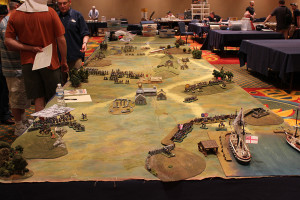
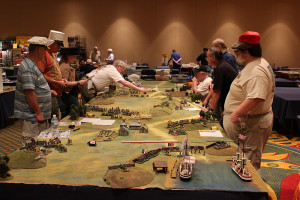
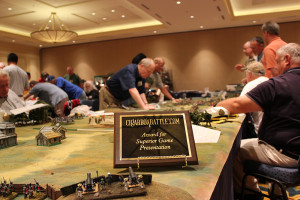
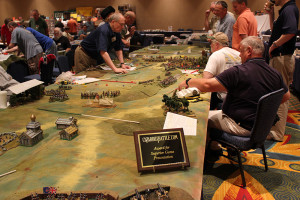
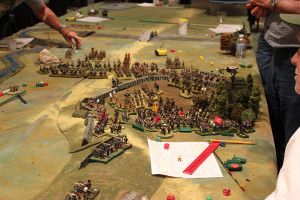
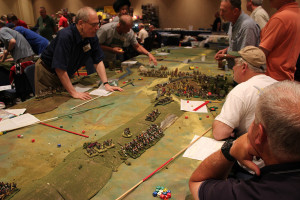
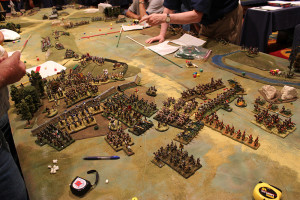
This is just another great example of the excellent quality games you will find every year at Nashcon. David is thinking about running his massive 28mm pirate game next year and that is definitely something that you don’t want to miss! See you at Nashcon next year!
DLR
